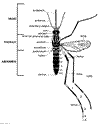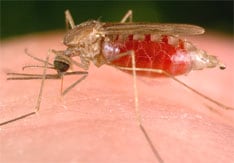QUESTION
What is malaria usually caused by?
ANSWER
Malaria is caused by a parasite called Plasmodium, which is transmitted via the bites of infected mosquitoes. In the human body, the parasites multiply in the liver, and then infect red blood cells. Usually, people get malaria by being bitten by an infective female Anopheles mosquito. Only Anopheles mosquitoes can transmit malaria and they must have been infected through a previous blood meal taken on an infected person. When a mosquito bites an infected person, a small amount of blood is taken in which contains microscopic malaria parasites. About 1 week later, when the mosquito takes its next blood meal, these parasites mix with the mosquito’s saliva and are injected into the person being bitten.
If you have ever taken anti-malaria medication, please take this brief Malaria Survey.




 Top: Anopheles Egg; note the lateral floats.
Top: Anopheles Egg; note the lateral floats. Anopheles Larva. Note the position, parallel to the water surface.
Anopheles Larva. Note the position, parallel to the water surface.



 Anopheles Pupa
Anopheles Pupa
 Anopheles Adults. Note (bottom row) the typical resting position.
Anopheles Adults. Note (bottom row) the typical resting position.
 Female Anopheles dirus feeding
Female Anopheles dirus feeding